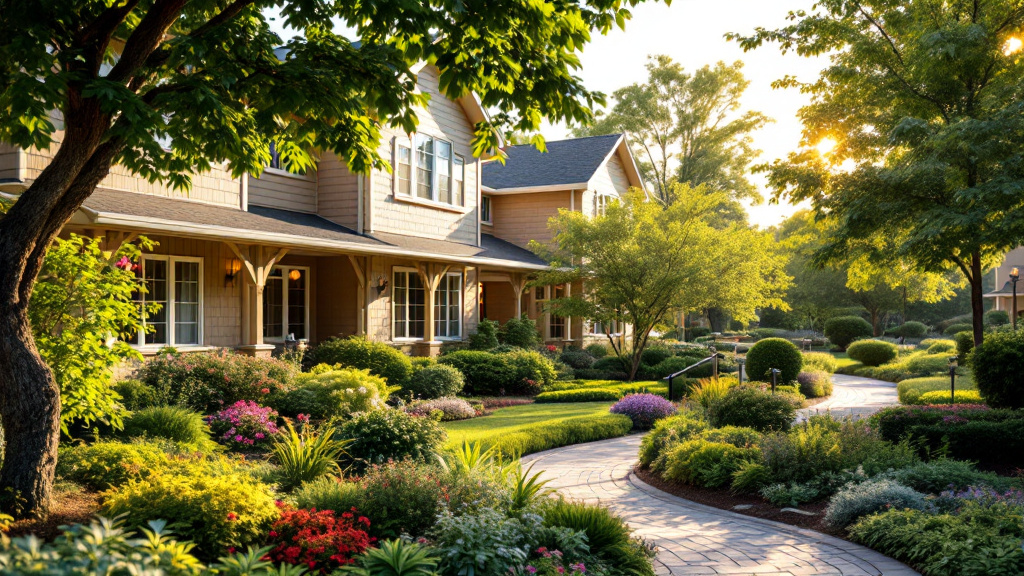How Assisted Living Encourages Healthy Habits for Seniors

Introduction
As the population ages, finding ways to support healthy lifestyles among seniors becomes increasingly crucial. Assisted living communities have emerged as a significant resource in this pursuit, offering a blend of social, physical, and mental health benefits. This article delves into how these communities are structured to foster healthy aging through a variety of services and programs, effectively encouraging seniors to lead active, fulfilling lives.
Promoting Social Interaction and Emotional Well-being

How can assisted living communities promote healthy lifestyles among seniors?
Assisted living communities actively cultivate an environment that prioritizes social interaction, significantly contributing to the prevention of isolation among seniors. These interactions are crucial for enhancing emotional well-being, enabling residents to form friendships and support systems, which are vital for mental health.
Furthermore, these communities encourage regular physical activity through a variety of programs, aiming for residents to engage in at least 150 minutes of moderate exercise weekly. Activities like chair yoga and water aerobics not only improve balance and mobility but also enhance sleep quality and reduce symptoms of depression.
Nutrition also plays a significant role. Seniors are guided on maintaining a balanced diet, with options like the Mediterranean and DASH diets that have been shown to mitigate risks of chronic diseases. Regular health screenings and check-ups facilitate early detection and management of health issues, ensuring residents maintain optimal wellness.
In addition to physical and nutritional health, residents are offered opportunities for continuous learning and engagement through workshops and hobbies. This engagement fosters cognitive health, while resources for stress management help support emotional resilience. In summary, assisted living communities cultivate a supportive, active environment that champions healthy lifestyles, essential for improving overall well-being for seniors.
Physical Activity and Wellness Programs

Fitness Programs
Senior living communities offer a variety of fitness programs tailored to the diverse needs and abilities of their residents. These can include chair yoga, water aerobics, and walking clubs, aiming to provide engaging options for all levels of mobility. With structured exercise classes and easy access to fitness amenities, residents are encouraged to stay active and explore their physical capabilities.
Health Benefits of Exercise
Regular physical activity is essential for seniors to maintain their health. Engaging in fitness programs can enhance cardiovascular health, boost cognitive function, and strengthen muscles. Physical activity releases endorphins, which help reduce stress and combat feelings of loneliness and depression. In a supportive environment, these benefits become increasingly accessible, as residents find motivation and enjoyment in their routines.
Reducing Chronic Disease Risks
Staying active significantly reduces the risk of chronic diseases among seniors. Programs focusing on physical fitness help manage weight, lower blood pressure, and support overall well-being. Research shows that participating in regular exercise can decrease susceptibility to conditions like heart disease and diabetes, allowing residents to lead healthier, more fulfilling lives. With tailored wellness initiatives in place, seniors can achieve improved health outcomes while enjoying a vibrant community atmosphere.
Nutrition and Diet: Supporting Healthy Living

Balanced Meals
In senior living communities, nutrition is prioritized with well-balanced meals tailored to the dietary needs of residents. These meals often feature fresh vegetables, lean proteins, and whole grains, contributing to optimal health and fighting the risks of malnutrition. The dining experience is designed not only to nourish but also to promote social interaction, as meals are served in a communal setting, reducing feelings of isolation.
Nutritional Guidance
Residents benefit from professional nutritional support, including personalized meal plans created by registered dietitians. This guidance empowers seniors to make healthier choices, ensuring they receive essential nutrients while managing their health conditions. Educational workshops on topics like mindful eating and healthy meal prep further inform residents on maintaining a nutritious diet.
Dietary Support for Chronic Conditions
Many senior living facilities offer specialized dietary accommodations to cater to residents with chronic conditions such as diabetes or hypertension. By customizing meal options, these communities help residents safely enjoy food while managing their health effectively. Access to culinary teams also means that favorite traditional holiday meals are prepared in healthier versions without sacrificing taste.
Advantages and Disadvantages of Assisted Living

What are the advantages and disadvantages of assisted living for the elderly?
Assisted living offers numerous benefits tailored to promote healthier aging among seniors. One notable advantage is the assistance with daily activities such as bathing, dressing, and meal preparation. This support not only helps prevent injuries but also ensures that seniors receive nutritious meals without the burden of cooking on their own. In addition, residents have ample opportunities for social interaction, which has been shown to enhance mental well-being through regular engagement with peers.
However, there are some potential drawbacks to consider. The average annual cost of assisted living exceeds $40,000, posing a significant financial challenge for many families. Additionally, privacy can be a concern, as the constant presence of staff and fellow residents may limit personal space. Moreover, assisted living communities may lack the round-the-clock medical care provided by nursing homes, making them less ideal for seniors with chronic health conditions requiring intensive medical attention.
Here’s a comparison of the main aspects of assisted living and independent living:
| Feature | Assisted Living | Independent Living |
|---|---|---|
| Daily Assistance | High level of support for daily activities | Minimal personalized support |
| Cost | Average annual cost: $40,000+ | Varies widely based on location and amenities |
| Social Opportunities | Structured social activities and community events | Community events but less structured |
| Medical Care | Limited medical support | No medical support provided |
| Ideal For | Seniors needing assistance with daily tasks | More independent seniors without major health issues |
In conclusion, while assisted living creates an environment focused on healthy aging and social engagement, potential residents must weigh these benefits against the costs and suitability for their personal health needs.
Adjusting to Life in Assisted Living

How long does it generally take for seniors to adjust to assisted living?
On average, it takes about three to six months for seniors to adjust to assisted living. This period can differ significantly based on individual circumstances and support systems in place.
What emotional transitions do seniors experience?
During this adjustment, seniors often grapple with a mix of emotions, including relief, guilt, and sadness. Recognizing these feelings is important, as they can impact how quickly one settles into their new environment.
How does assisted living enhance safety and support?
Assisted living facilities provide essential safety and medical support that can substantially reduce common risks, such as falls. Annually, about 33% of seniors experience falls at home, making the transition to such environments a safer choice. The social structure found in these communities also promotes emotional well-being, helping to alleviate feelings of loneliness and depression. The growing demand for assisted living highlights their crucial role in enhancing elder care and improving quality of life.
| Adjustments Required | Emotional Transitions | Safety Improvements |
|---|---|---|
| Takes 3-6 months | Relief, guilt, sadness | Reduced fall risks |
| Varies by individual | Important to recognize | Enhanced medical support |
| Involves specific adjustments | Affects settling time | Promotes emotional well-being |
Intellectual Engagement and Lifelong Learning
Cognitive Stimulation
Engaging in activities that stimulate the mind is fundamental for seniors, as it plays a significant role in maintaining cognitive health. Programs that include puzzles, memory games, and brain-teasing challenges are essential in preventing cognitive decline. Many communities incorporate these activities into their daily routines, encouraging residents to actively participate.
Opportunities for Learning
Senior living communities often offer varied learning programs, such as art classes, computer courses, and guest lectures. Lifelong learning not only keeps seniors intellectually engaged but also nurtures curiosity, allowing them to explore new interests and skills. Educational workshops on health and wellness empower residents to incorporate healthy practices into their daily lives, enhancing both mental and physical well-being.
Hobbies and Mental Health
Pursuing hobbies is vital for emotional health. Whether it’s painting, gardening, or reading, these activities provide a sense of purpose. Community support fosters environments where residents can engage with peers and form connections through shared interests, reducing feelings of loneliness. Volunteers also contribute significantly by sharing skills and facilitating workshops, which nurture social bonds and enhance overall happiness.
Holistic Wellness and Safety Measures
What Safety Measures are Implemented in Senior Living Communities?
Safety is paramount in senior living communities, ensuring residents feel secure in their environments. Facilities often have emergency response systems, security features, and trained staff members available 24/7. These measures help to quickly address health emergencies or safety concerns, fostering peace of mind for both residents and their families.
How is Round-the-Clock Support Provided?
Round-the-clock support is a cornerstone of assisted living. Trained caregivers are on-site at all times, ready to assist residents with daily activities and healthcare needs. Regular health assessments help to personalize care plans, ensuring that residents receive the specific support they require. This continuous availability not only enhances physical well-being but also improves emotional support and community bonds among residents.
What are Holistic Wellness Programs?
Holistic wellness programs in senior living communities address the multifaceted aspects of resident health, combining physical, mental, and emotional wellness. These programs often include fitness classes tailored to various mobility levels, wellness education workshops, and social activities like art classes and volunteer opportunities. By linking social engagement with health initiatives, these programs empower residents to lead active, fulfilling lives while minimizing risks associated with isolation and loneliness.
| Aspect | Features | Benefits |
|---|---|---|
| Safety Protocols | Emergency systems, trained staff | Immediate response to emergencies, enhanced peace of mind |
| 24/7 Support | Accessible caregivers, regular assessments | Consistent care tailored to individual needs |
| Holistic Wellness | Fitness classes, wellness workshops | Promotes physical health, emotional well-being, and social engagement |
Conclusion
Assisted living facilities present an environment where seniors are encouraged to thrive, both physically and mentally. By prioritizing a balanced approach to social interaction, nutrition, fitness, and continuous learning, these communities effectively support seniors in maintaining their health and well-being. As research indicates, the structured support system inadvertently reduces rates of loneliness and depression, promoting not just longer, but happier and healthier lives for seniors.
References
- Top 11 Health Benefits of Senior Living | Where You Live Matters
- 7 Ways Senior Living Encourages Happy, Healthy Aging
- Healthy Tips for Older Adults in Assisted Living Facilities
- 7 Ways Senior Communities Promote Health & Wellness
- Healthy Lifestyle Tips for Seniors in Assisted Living
- 7 Ways Assisted Living Communities Improve Quality of Life for ...
- Why Senior Living Promotes a Healthier and Happier Life
- 10 Ways the Top Senior Living Communities Promote Healthy Aging









































.jpg)







.jpg)





.jpg)
.jpg)
.jpg)
.jpg)
.jpg)
.jpg)
.jpg)
.jpg)



.jpg)

.jpg)
.jpg)
.jpg)
.jpg)


.jpg)
.jpg)
.jpg)
.jpg)

.jpg)
.jpg)
.jpg)


.jpg)
.jpg)










.jpg)
